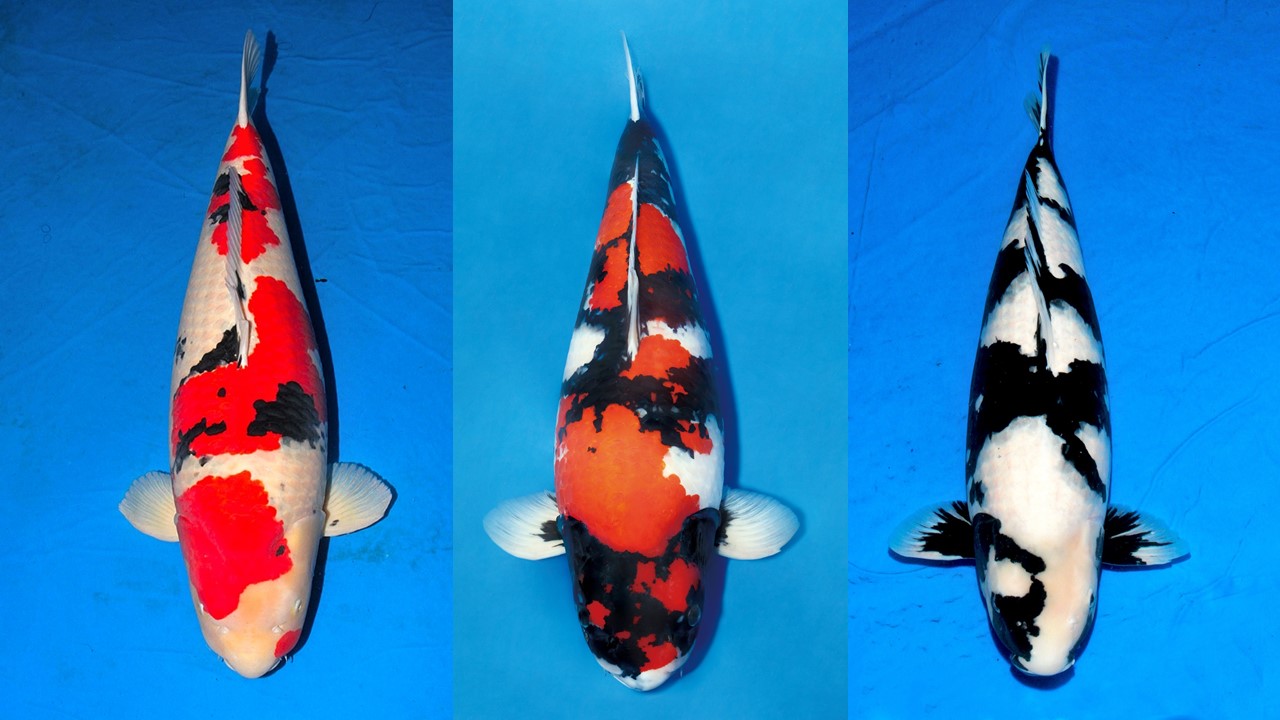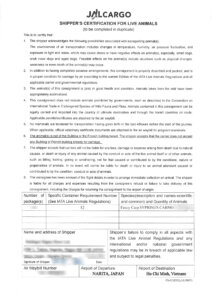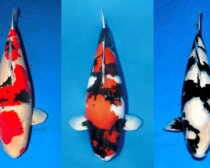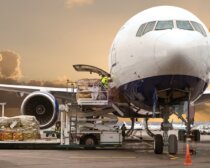"Living Art" Forged by the Snow: The History of Nishikigoi
The primary production areas for Nishikigoi, particularly the regions around Nagaoka City and Ojiya City in Niigata Prefecture, are lands born from a combination of harsh nature and human ingenuity. In this heavy snowfall region, people originally raised edible carp to secure food supplies during the long winters.
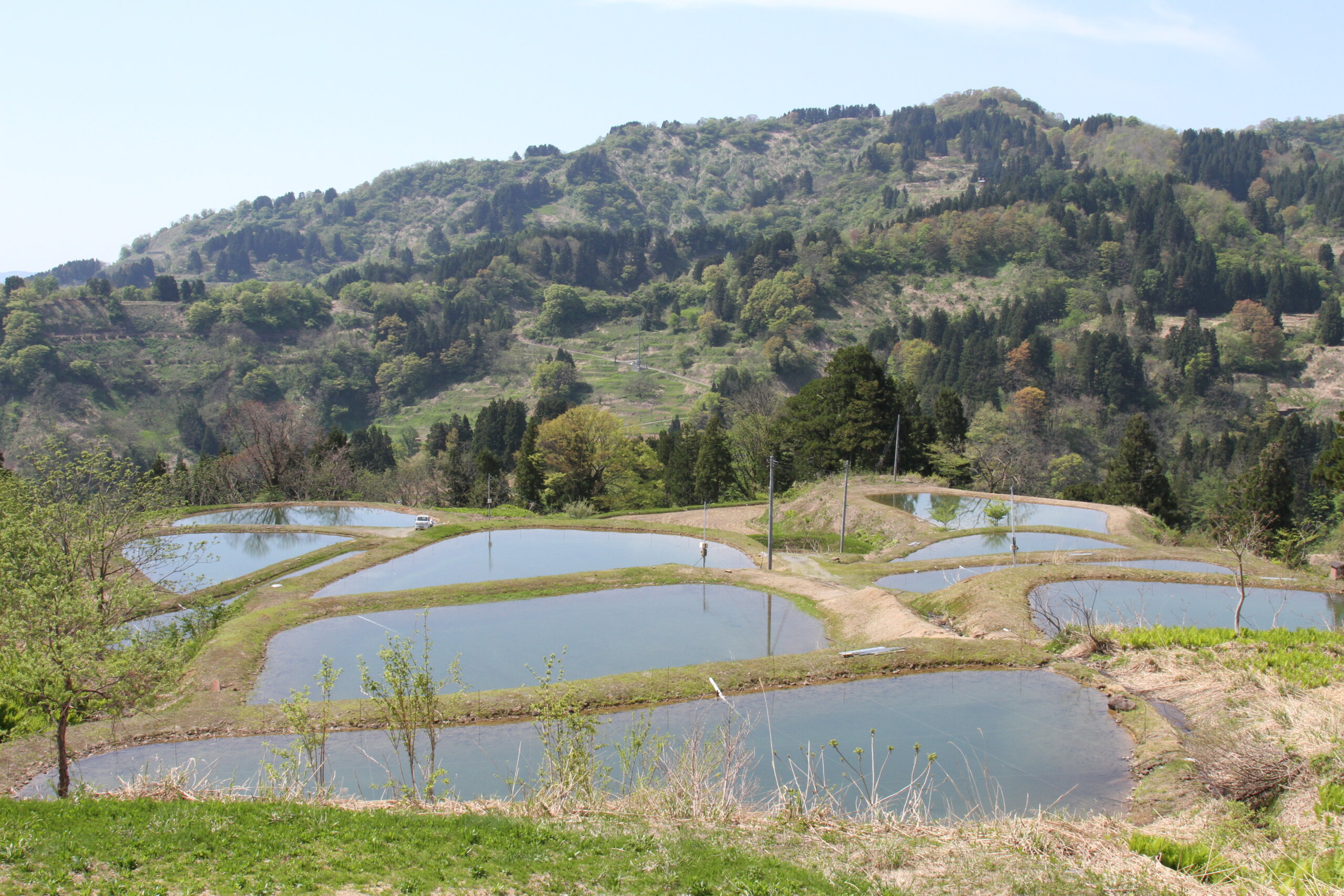
Breeding Ponds (Noike)Utilizing Terraced Rice Fields in Mountainous Regions
The pivotal shift from food source to ornamental fish began when a spontaneous mutation produced carp with strikingly vibrant colors. Through repeated cross-breeding and dedicated refinement, the beautiful Nishikigoi we see today were finally born.
The fish’s beautiful color, luster, and robust health are nurtured by the mineral-rich, clear streams created by the melting snow. Furthermore, the innovative spirit of previous generations—such as utilizing sloped rice terraces as breeding ponds—allowed these “swimming works of art” to evolve. This ingenuity, born from a challenging natural environment, laid the foundation for the Nishikigoi to spread its wings across the globe.
Expertise and Innovation in Raising Nishikigoi
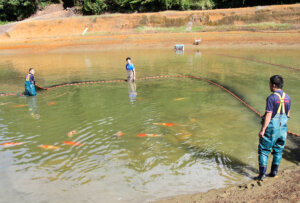
Autumn Transfer: Moving the koi back indoors. (Niigata Koi Direct)
Koi farming is deeply intertwined with the changing of the seasons. In the spring, from May to June, when the water warms, the fry that have been raised in indoor facilities are released into the “Noike” (outdoor mud ponds) in the mountainous regions, which are fed by melting snow. After spending about half a year growing in this natural environment, they are returned to the indoor facilities around October. This time, when the koi are brought back indoors, marks the start of the buying season, with dealers and buyers from all over the world visiting Niigata. Transactions become active and shipping peaks from October to December. Since transportation risks increase after April, when water temperatures rise, this period becomes the off-season for exports.
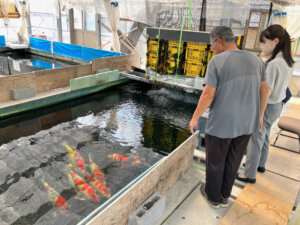
The indoor facilities also contain large koi being kept for clients.
In the export market, preferences for varieties and sizes differ by country. In Europe, imposing adult koi with a powerful presence, particularly the distinctive “Hikari-mono” (metallic varieties) and “Kawarigoi” (unique, non-standard varieties), are popular. In contrast, Asia tends to favor the traditional “Gosanke” (the Big Three: Kohaku, Taisho Sanshoku, and Showa Sanshoku), and there is a tendency to purchase fry (young koi) with an eye on their future growth potential. Modern, swift cross-border transactions have become routine, with many sales being initiated by international dealers who place orders after viewing videos filmed at the koi farms.
The Keys to Export: Temperature and Oxygen Management
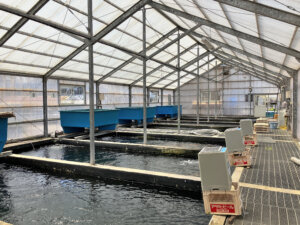
Numerous tanks inside the indoor facility. (Hoshikin Koi Farm)
Exporting delicate Nishikigoi demands advanced expertise and specialized techniques. Once a koi is designated for export, it is moved to a separate tank, and transportation preparations begin. The fish are placed into a tank filled with fresh, clean groundwater, and are subjected to feed restriction (fasting) starting about one week before shipment. This fasting is essential to prevent water quality deterioration during transit. Great care is taken to ensure the environment within the tank is pristine, as the fish may even eat moss or algae adhering to the tank walls and nets. Despite how severe this may seem for the koi, they are hardy enough to tolerate fasting for as long as two to three weeks.
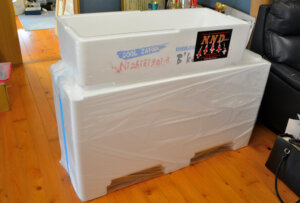
Specialized Styrofoam Containers Developed for Koi
The most critical factors during transport are temperature control and oxygen levels. Since Nishikigoi are vulnerable to sudden changes in water temperature, Niigata Koi Direct, whom we interviewed, takes meticulous care to maintain the water temperature at around throughout the journey. Considering the extreme conditions in certain destinations—where temperatures can drastically differ from Japan—koi are at risk of being exposed to in winter Europe or over in Southeast Asia while awaiting customs clearance. To appropriately manage and sustain the water temperature under these conditions, the company uses dedicated, specialized Styrofoam containers year-round for export. These containers, developed specifically for koi transport, are highly insulated and robust. They include features like forklift pockets and anti-slip finishes, which have successfully solved the issues of cargo collapse and water leakage during international shipping.
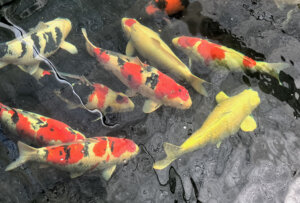
The thickness of the body is just as important as the color and pattern.
Preventing oxygen deprivation during transport is equally crucial. Since the Dissolved Oxygen (DO) level in water increases as the temperature decreases, maintaining proper temperature control is essential. Furthermore, an additional measure is taken: the inclusion of a special chemical pack in the packaging that absorbs carbon dioxide and releases oxygen. These combined efforts and innovations make it possible to safely transport large Nishikigoi, which can grow to be 80 to in length. Packed in their specialized cases, these shipments—including the water—can weigh a total of 80 to .
Air Transport Schedule: A Race Against Time
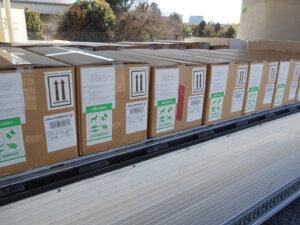
Nishikigoi arriving at Narita International Airport.
The export of Nishikigoi is truly a race against time. Unlike standard cargo shipping, the entire process—from preparing documentation to arranging transport logistics—must be calculated backward from the confirmed flight schedule.
Let’s look at a real-world schedule for a shipment to Vietnam:
5:00–6:00 AM: Export packing begins at the koi farm.
6:30–7:00 AM: Packed koi are collected from multiple farms. The convoy immediately heads for Narita Airport via the Kan-Etsu Expressway.
Approx. 12:00 PM: Arrival at a facility near Narita Airport. Export declarations are completed while the cargo is still on the truck, with customs clearance typically granted around 1:00 PM.
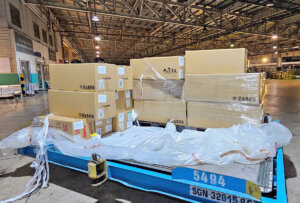
The koi shipment upon arrival at a Vietnamese airport.
2:32 PM: The koi are brought into the airline’s cargo terminal, awaiting loading onto the aircraft.
5:48 PM: Departure from Narita Airport, heading for Ho Chi Minh City, Vietnam.
10:19 PM (Vietnam Time): Arrival in Ho Chi Minh City after approximately a six-and-a-half-hour flight.
12:06 AM (Next Day): Following customs procedures, the handover to the importer is successfully completed.
Necessary Documentation for Nishikigoi Export
In addition to the essential commercial documents required for general trade, such as the Invoice and Packing List, the export of Nishikigoi requires three specific, unique documents:
1.Shipper’s Certification for Live Animals: This specialized document is submitted to the airline. It is essential for clearly defining the safety and health status of the animals during transport, as well as clarifying the division of responsibilities with the airline.
2.Health Certificate: This certificate verifies that the koi meet the specific quarantine requirements of the destination country. For Nishikigoi, this is the most critical document for customs clearance, as it must contain the results of disease inspections, such as for the Koi Herpes Virus ().
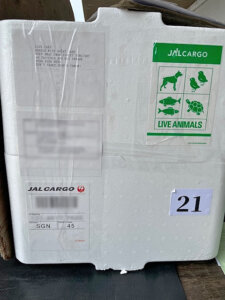
LIVE ANIMAL and other warning labels.
3.Certificate of Origin: This document is typically attached as it serves to authenticate the value of the Nishikigoi as a part of Japanese traditional culture. By verifying the item’s origin in Japan, it significantly enhances reliability. The producer field on this certificate lists the names and contact information of the multiple koi farms involved in the production.
Furthermore, the exterior of the cargo must carry labels specific to animal transport, which are not seen on general merchandise.
Ground Transport and Schedule Management: The Reality of Koi Shipping
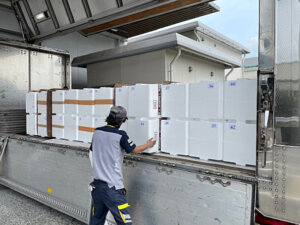
Nishikigoi on the truck bed, always positioned 90 ∘ perpendicular to the direction of travel.
Specialized expertise is also required for the ground transport that carries Nishikigoi to the airport. While avoiding rapid temperature changes and excessive vibration is essential, a specific technique is used when loading the cargo onto the truck: the koi boxes are placed 90∘ perpendicular to the direction of travel. This ensures that the pressure is evenly distributed across the fish’s bodies, enabling stable transport.
The entire transport operation is a race against time, with the goal of getting the koi from their pond in Japan to the pond overseas within a maximum of 35 hours. Therefore, arranging a direct flight is the golden rule. However, unexpected troubles have occurred in the past, such as forced transits or delays in loading that required re-packaging at the airport. To prevent such incidents, the presence of a transport agent with the necessary expertise and experience—versed in not only the Japanese side but also in customs clearance and domestic transport in the destination country is vital.
Meanwhile, preparations are also made on the Vietnam side. Typically, Vietnamese importers initiate close contact with the Japanese side about a week before shipment. They arrange administrative documents and secure vehicles for domestic transport. Confirmation is made with all parties involved to ensure the entire flow is seamless and without delays. Upon arrival at the airport, after various procedures, the koi are finally moved into an isolated pond provided by the consignee, separate from other fish. Samples are collected from the pond for various tests, and only after these are completed is final import permission granted.
Globalizing Japan's Art: How Nissin Connects Nishikigoi to the World
Exporting Nishikigoi requires complex procedures and a high degree of specialization. We at Nisshin manage the entire process—working closely with producers and overseas buyers—to ensure the koi are delivered safely and promptly to their destination.
Nisshin’s involvement in koi transport began with our local subsidiary in Vietnam, Nisshin Vietnam, which established contact with a Vietnamese importer and initiated the exports from Japan. To establish this transport system, Nisshin Vietnam staff undertook long-term stays in Niigata to acquire knowledge and techniques firsthand in the field. This practical learning is our invaluable asset in Nishikigoi transport.
Koi export must satisfy all Japanese laws and the quarantine requirements of the importing country. We not only handle the complex procedures based on the IATA (International Air Transport Association) Live Animals Regulations (LAR), which differs from general cargo, but we also act as the “coordinator” between the exporter and the importer to facilitate safe and smooth transport.
The Nishikigoi is the only ornamental fish to originate in Japan, and we send this Japanese treasure out to the world. Nisshin will continue to play a role in connecting this value to the future, ensuring that the “Swimming Jewels” remain cherished globally.
Acknowledgements (in no particular order):
Niigata Koi Direct Co., Ltd.
https://www.koi-direct.co.jp/
Hoshikin Koi Farm Co., Ltd.
https://www.city.ojiya.niigata.jp/site/tokiwabashi/tokiwabashiproject-hoshikinkoifarm.html

